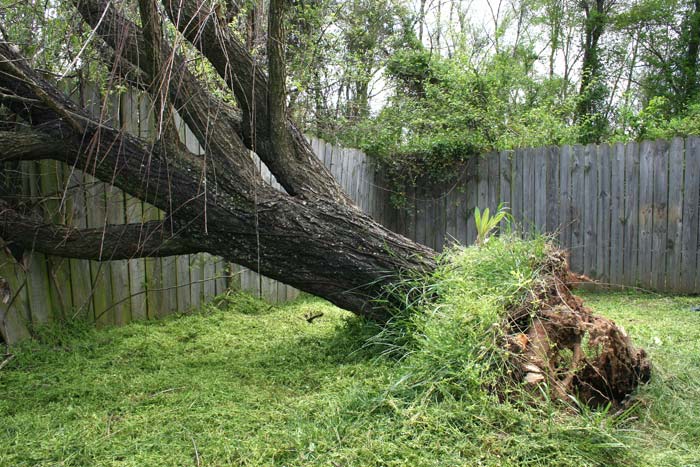We live in a society that loves trees. We find comfort in trees and even name streets after them. We picture our dream American home with a nice green lawn in the front yard along with flowering shrubs and a beautiful shade tree to top if off — all on Maple Ave., a street that is lined on both sides with lush, perfectly green, towering trees. We, Americans love our trees so much that a minority of us will even spend hours chained up to a beloved tree in order to protect it from harm. We will spend hundreds or thousands of dollars a year to maintain and care for our trees. But how do you know when your trees that bring a sense of comfort and a touch of nature to your property is actually a life-threatening hazard?

SOME TREES FALL. SOME TREES DON’T. WHAT GIVES?
Unfortunately, all trees have some potential to fail during heavy winds or other harsh elements, such as snow and ice. Limbs fall and whole trees topple at the root as a result of “windthrow” — as the word suggests, the potential to be “thrown” or pushed by the wind. In these incidences, the tree trunk acts as a lever and the force applied to the roots and trunk increases with height and mass. Taller trees are more susceptible to windthrow. Taller trees with heavy foliage that wind has a difficult time blowing through are more susceptible to windthrow. Furthermore, taller trees with heavy foliage and weak roots makes an even more unstable situation.
STRONG ROOTS. STRONG TREE.
Roots are the anchor to a tree, acting as fingers that expand and hold onto the earth beneath. Larger root mass equals stronger hold. However, there are factors that can upset the sturdiness of the root system. The roots of trees typically extend 1-2.5 times the radius of the branches, but unfortunately this expansion can be hindered due to poor planting techniques, infrastructure crowding, and root damage. When planting a tree or planning construction around a tree, it is important to have the tree’s full canopy size and root structure in mind. The growth of many urban trees is neglected to be considered with new construction and land development. It is common to see massive trees surrounded by concrete walkways, road development, and buildings. In these situations the root system was either severed or impeded, thus hindering the support of these lofty trees.
Imagine it this way. If you take a tennis racket and tape it upright onto an square piece of cardboard measuring 4 inches by 4 inches, and you take another tennis racket and tape upright onto a piece of cardboard measuring 20 inches by 20 inches — which do you think would be less likely to fall?
HOW CAN YOU AVOID TREE FAILURE?
Deep water your trees. Frequent, short watering sessions will cause roots to stay near the surface where their water supply is located. However, if they are given less frequent, plentiful waterings, it will compel the roots to dig deeper into the ground in order to obtain their water supply. Have your trees pruned (another term for trimmed) on a regular basis. Small amounts of pruning over the first 2-10 years will help ensure strong tree structure and will avoid large pruning cuts that can harbor decay and weaken the structure of the tree. Each time a tree is trimmed, it should only be pruned up to 15-20%. Anything more may weaken the tree by putting it into shock, making the tree more susceptible to disease and pests, and/or causing the tree to use up its stored energy to heal its large wounds and to compensate for growth spurts that typically follow a large trimming. Avoid severing roots or impeding root growth with construction on your property. Avoid topping the tree, or in words, cutting the top of the tree to shorten its stature. This type of pruning can cause cuts to be made to large limbs. When large limbs are cut, the result is a substantial wound that penetrates deep into the limb, weakening the structure. Following these cuts, trees sprout out new limbs surrounding the weak woundwood. Since these new limbs grow with a frail base, they are weak, hazardous, and susceptible to failure if too much pressure (and it does not take much) is put on the limb. Skilled tree trimmers know to avoid climbing onto these branches, because they typically cannot support their weight. If you suspect that your tree may be susceptible to failure, have a Certified Arborist inspect your property. Investing small amounts periodically will go a long way to preserve the health and safety of your beloved tree.
If you suspect that you have a dangerous tree, please contact a local tree professional in your area. San Diego residents may contact LC Tree Service for a free estimate and evaluation.

